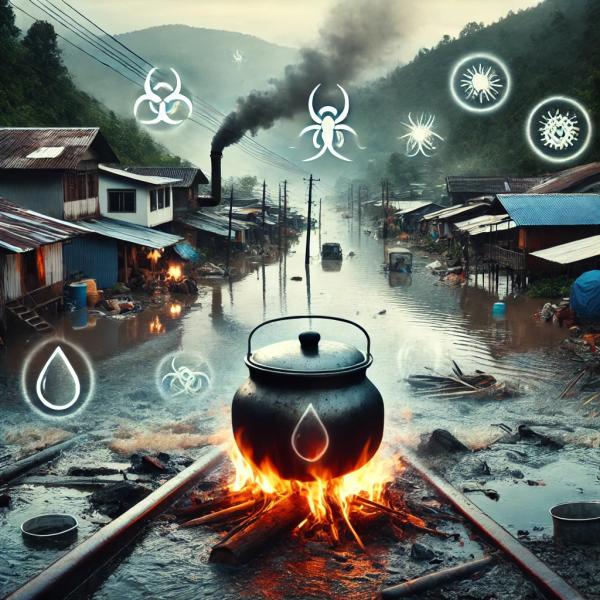
When Hurricane Helene struck western North Carolina on September 26, 2024, the damage and loss of life were unprecedented – 96 storm-related deaths and at least $53 billion in damages. For seven weeks after the storm, citizens of Asheville had to boil their water before drinking or cooking. Public health officials and emergency response planners often overlook the lack of potable water, an essential service. Let’s look at some of the challenges
We Have Been Here Before
Hurricane Helene tore through the mountains, rivers, and towns of western North Carolina with unimaginable force. We like to think that today, we are experts in emergency preparedness, and past tragedies will not repeat themselves. But sadly, this is not always the case, as shown by the “Great Flood” of 1916 in western North Carolina.
The 1916 storm was caused by a Category 2 hurricane that hit Charleston, South Carolina, and one day later, the storm brought rainfall and catastrophic flooding to western North Carolina. Rain totals ranged from 5 inches to over 20 inches within a 24-hour period, which led to more than 80 deaths, dams being breached, destroyed hundreds of homes, and significant damage to power plants and railroads.
Like the 1916 flood, Hurricane Helene began with a hurricane hitting a southern state (this time, it was Florida instead of South Carolina) and then excessive rain, 14 inches to 31 inches (breaking the record from 1916). There were 96 deaths, hundreds of people reported missing, thousands were left without homes, electricity, or water, and many roads were undrivable.
Water Problems
The diagram below shows a typical drinking water treatment plant. Water is taken from a lake or reservoir and treated to remove contaminants, including inorganic and organic chemicals and potentially harmful microbes. The greatest microbial risks are associated with water contaminated with human or animal (including bird) feces.
After the water is treated, it is pumped to homes and businesses through a water distribution system consisting of storage facilities, pumps, and pipes. Water may be stored in surface reservoirs or, as shown in the diagram, in water towers (elevated water tanks). From there, water is pumped to homes and businesses through a series of pipes. Water mains are pipes laid within the public right of way that transport water within a water distribution system. These consist of primary feeders (large-diameter water mains), secondary feeders (smaller water mains), and service lines (small-diameter pipes used to connect from a water main to a water meter).
Western North Carolina is a mountainous area with steep slopes and hard-to-navigate roads. The water treatment plant for the city of Asheville, including the city’s primary reservoir, is in the mountains above the city. The flood destroyed pipes that took water from this treatment plant to the city of Asheville and caused the reservoir to be “flipped upside down,” with suspended clay particles from the bottom moving to the top, leaving the water murky and undrinkable. This is currently being treated with aluminum sulfate, which causes clay particles to coagulate and sink to the bottom and caustic soda to regulate the pH.
More than 6,900 roads and bridges were damaged in the storm, making it difficult to bring in equipment and supplies needed to repair the damaged water systems. Some areas of the state had restrictions on the size of trucks that could be used due to damage to main roads. A new road had to be built to reach a second reservoir knocked offline by the storm to supply water to the parts of Asheville served by their primary reservoir.
As of October 22, non-potable water, used for flushing toilets and taking showers, was back to about 95% of the citizens of Asheville. But the water still needed to be boiled before drinking or cooking.
Not all the residents of western North Carolina are served by public water systems. More than 300,000 people near the flood-impacted area of western North Carolina are estimated to rely on private wells, and the number of septic systems is slightly higher. North Carolina is a largely rural state, with the largest number of households served by private wells in the US. The federal government does not regulate these wells under the Safe Drinking Water Act, and individual households are responsible for cleaning their drinking water.
The North Carolina Department of Health and Human Services recommended that for people with private wells they be tested by the local health department and disinfected as needed.
After experiencing the water shortages after Hurricane Helene, some residents are taking matters into their own hands by digging back-up wells. One well digger in western North Carolina said there is a nine-month waiting list for people wanting to have wells dug to sources of water that won’t be vulnerable to flooding. However, a new well is not cheap; the average cost of a 300-foot well is $18,000, and a 600-foot well could be more than $24,000.
What are the Health Risks?
The major concern from disruption to potable drinking water is gastrointestinal infections causing vomiting and diarrhea, resulting from bacteria such as E. Coli, which can be found in the contaminated water. According to a North Carolina epidemiologist, the State is worried about increases in Legionnaires Disease, hepatitis A, campylobacter, and other infections.
Exposure to floodwaters can cause skin rashes and infections, which can result from exposure of open wounds to the water. After the flood water has receded, standing water creates the perfect environment for mosquitoes.
I have previously written about the dangers of cyber-attacks on public water systems, but for too long, natural dangers, such as floods, have not been addressed. Areas of the country that do not often experience hurricanes (such as western North Carolina) have unique vulnerabilities, consisting of older infrastructure, mountainous terrains, and many private wells. It is essential for local governments to build contingency plans to address the unique challenges facing these areas.




